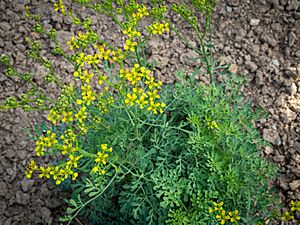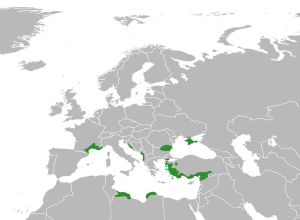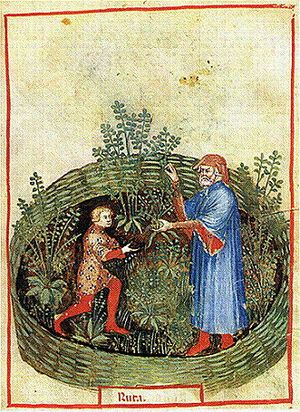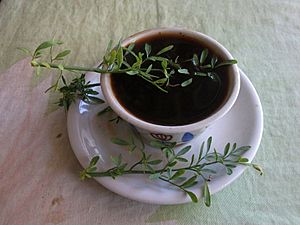Common rue facts for kids
Quick facts for kids Common rue |
|
|---|---|
 |
|
| Common rue in flower | |
| Scientific classification | |
 |
Ruta graveolens, often called rue or common rue, is a plant grown for its pretty look and as a useful herb. It comes from the Balkan Peninsula in Europe. Today, you can find it in gardens all over the world. People like its blue-green leaves. It can also grow well in hot, dry soil.
Rue is used as a medicinal plant in places like Ethiopia and Eritrea, where it's called "Tena adam" (meaning "Health for Adam"). It's also used in cooking, to keep insects away, and sometimes as incense.
Contents
What's in a Name?
The scientific name graveolens means "strong-smelling." This is because the plant's leaves have a very distinct smell.
How People Use Rue
Old Traditions
Long ago, people believed rue had special powers. Ancient Roman writers like Pedanius Dioscorides and Pliny the Elder suggested mixing rue with another plant called oleander. They thought this mixture could be an antidote for snake bites.
A medieval book about health, called the Tacuinum Sanitatis, listed some interesting things about rue:
- It was thought to make eyesight better.
- It was also believed to help with gas in the stomach.
Cooking with Rue
Rue can be used in cooking, but only in very small amounts. It has a bitter taste, and too much can make some people feel unwell. It's not a common herb in most kitchens today.
However, rue is an important part of berbere, a special spice mix from Ethiopia and Eritrea. In Ethiopia, people sometimes dip fresh rue into their coffee before drinking it.
Because rue contains small amounts of natural chemicals, it's very important to use it carefully. Pregnant women should avoid it completely. Also, if the plant's juice gets on your skin and then the sun shines on it, it can cause a burn-like rash. So, be careful when touching it!
Here are some ways rue has been used in food:
- It was very popular in ancient Roman cooking.
- In Greece and other Mediterranean countries, it's used to add a traditional flavor.
- In parts of Italy and Croatia, a small branch of rue is put into a strong drink called grappa to give it a special taste. This drink is called grappa alla ruta.
- The seeds can be used to make porridge.
- The bitter leaves can be added to eggs, cheese, or fish.
- In some parts of Italy, young rue branches are dipped in batter, fried, and eaten with salt or sugar.
- It was even used to flavor beer in old times.
Other Uses
Rue is also grown just because it looks nice. People plant it as a small hedge or use its leaves in nosegays (small bunches of flowers).
Many cats don't like the smell of rue. Because of this, it can be planted to keep cats away from certain areas.
Some butterfly caterpillars, like those of the Papilio machaon and Papilio xuthus, enjoy eating rue plants.
In South India, people sometimes plant rue in their gardens to try and keep snakes away. However, we don't know for sure if this really works.
The Catholic Church used to use a branch of rue to sprinkle holy water. This is why it was sometimes called the "herb of grace."
Some Jewish traditions also believed that rue could protect people from sickness.
Around the world, rue is used in homes. In Central Asia, it's traditionally used to keep insects away and to make rooms smell better.
Is Rue Safe?
Eating small amounts of rue as a flavoring herb is generally safe. However, eating large amounts can be dangerous. It can cause stomach pain, vomiting, and even harm the liver. This is because rue contains natural toxic compounds.
It's very important to only use rue in tiny amounts for food. Pregnant women should never use it.
Also, if the sap or juice from the rue plant gets on your skin, and then your skin is exposed to sunlight, it can cause a severe skin reaction. This reaction can look like blisters or burns. Always wash your hands after touching rue.
Symbolic Meanings
The bitter taste of rue's leaves led to it being linked with the word "rue," which means "to regret." So, rue often stands for regret. It's also known as "herb-of-grace" in many stories.
In old myths, it was said that the basilisk, a creature whose breath could make plants wilt, had no effect on rue. Stories say that weasels bitten by a basilisk would eat rue to recover and then go back to fight.
In the Bible
Rue is mentioned in the Bible, in Luke 11:42. It says:
"But woe unto you, Pharisees! For ye tithe mint and rue and all manner of herbs".
In Lithuania
Rue is a very important plant in Lithuania. It's considered a national herb. You'll find it mentioned often in Lithuanian folk songs. It's a symbol for young girls, representing purity and maidenhood. In traditional Lithuanian weddings, only virgins would wear a rue plant (called rūta) as a sign of their purity.
In Jewish Culture
There is a traditional Sephardic wedding song called "Una Matica de Ruda" which means "A Little Branch of Rue."
In English Literature
Rue appears in many famous English writings:
- In William Shakespeare's play Hamlet, the character Ophelia gives out flowers, including rue, calling it "herb-grace o' Sundays."
- In Shakespeare's Richard II, a gardener plants rue where the Queen cried, calling it "sour herb of grace."
- In Milton's Paradise Lost, the angel Michael uses rue to help Adam see clearly.
- In Jonathan Swift's Gulliver's Travels, Gulliver uses rue to block out bad smells when he returns home.
Images for kids
See also
 In Spanish: Ruda para niños
In Spanish: Ruda para niños






